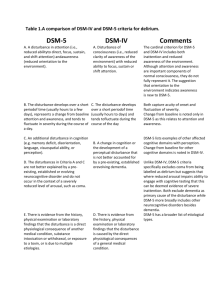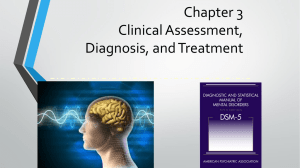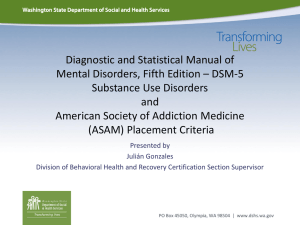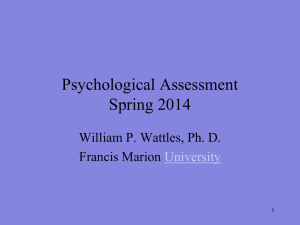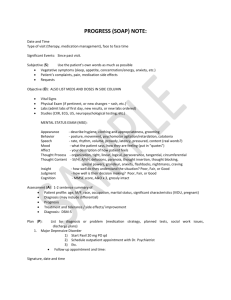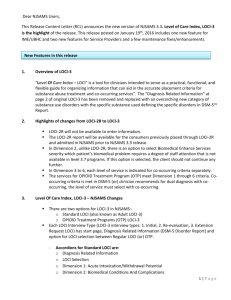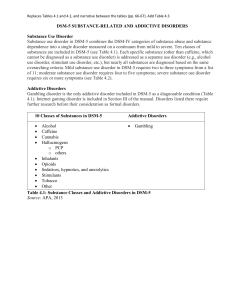DSM-5 Implementation FAQs for Clinicians
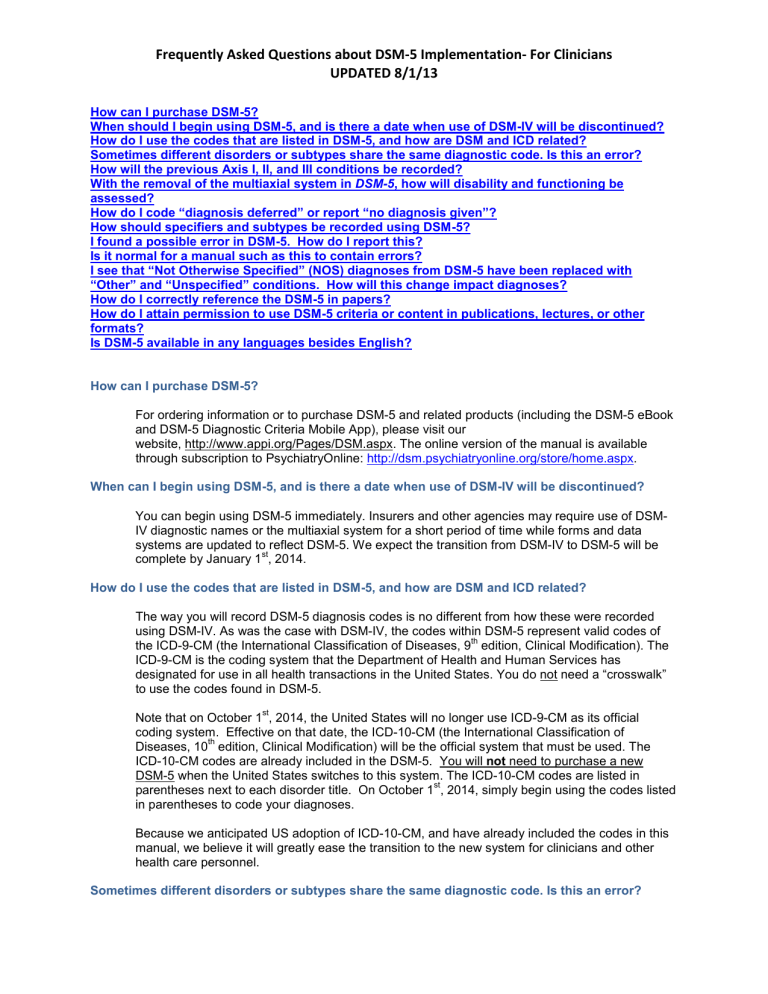
Frequently Asked Questions about DSM-5 Implementation- For Clinicians
UPDATED 8/1/13
When should I begin using DSM-5, and is there a date when use of DSM-IV will be discontinued?
How do I use the codes that are listed in DSM-5, and how are DSM and ICD related?
Sometimes different disorders or subtypes share the same diagnostic code. Is this an error?
How will the previous Axis I, II, and III conditions be recorded?
With the removal of the multiaxial system in DSM-5, how will disability and functioning be assessed?
How do I code “diagnosis deferred” or report “no diagnosis given”?
How should specifiers and subtypes be recorded using DSM-5?
I found a possible error in DSM-5. How do I report this?
Is it normal for a manual such as this to contain errors?
I see that “Not Otherwise Specified” (NOS) diagnoses from DSM-5 have been replaced with
“Other” and “Unspecified” conditions. How will this change impact diagnoses?
How do I correctly reference the DSM-5 in papers?
Is DSM-5 available in any languages besides English?
How can I purchase DSM-5?
For ordering information or to purchase DSM-5 and related products (including the DSM-5 eBook and DSM-5 Diagnostic Criteria Mobile App), please visit our website, http://www.appi.org/Pages/DSM.aspx. The online version of the manual is available through subscription to PsychiatryOnline: http://dsm.psychiatryonline.org/store/home.aspx
.
When can I begin using DSM-5, and is there a date when use of DSM-IV will be discontinued?
You can begin using DSM-5 immediately. Insurers and other agencies may require use of DSM-
IV diagnostic names or the multiaxial system for a short period of time while forms and data systems are updated to reflect DSM-5. We expect the transition from DSM-IV to DSM-5 will be complete by January 1 st
, 2014.
How do I use the codes that are listed in DSM-5, and how are DSM and ICD related?
The way you will record DSM-5 diagnosis codes is no different from how these were recorded using DSM-IV. As was the case with DSM-IV, the codes within DSM-5 represent valid codes of the ICD-9-CM (the International Classification of Diseases, 9 th
edition, Clinical Modification). The
ICD-9-CM is the coding system that the Department of Health and Human Services has designated for use in all health transactions in the United States. You do not need a “crosswalk” to use the codes found in DSM-5.
Note that on October 1 st
, 2014, the United States will no longer use ICD-9-CM as its official coding system. Effective on that date, the ICD-10-CM (the International Classification of
Diseases, 10 th
edition, Clinical Modification) will be the official system that must be used. The
ICD-10-CM codes are already included in the DSM-5. You will not need to purchase a new
DSM-5 when the United States switches to this system. The ICD-10-CM codes are listed in parentheses next to each disorder title. On October 1 st
, 2014, simply begin using the codes listed in parentheses to code your diagnoses.
Because we anticipated US adoption of ICD-10-CM, and have already included the codes in this manual, we believe it will greatly ease the transition to the new system for clinicians and other health care personnel.
Sometimes different disorders or subtypes share the same diagnostic code. Is this an error?
Frequently Asked Questions about DSM-5 Implementation- For Clinicians
UPDATED 8/1/13
No. It is occasionally necessary to use the same code for more than one disorder. Because the
DSM-5 diagnostic codes are limited to those contained in the ICD , some disorders must share codes for recording and billing purposes. For example, hoarding disorder and obsessivecompulsive disorder share the same codes (ICD-9-CM 300.3 and ICD-10-CM F42). We will be working with the ICD-10-CM revision conferences supported by CMS and NCHS to recommend separate codes for these new disorders as soon as possible.
Because there may be multiple disorders associated with a given ICD-9-CM or ICD-10-CM code, the DSM-5 diagnosis, whenever possible, should be recorded by name in the medical record in addition to listing the code. See our “Insurance Implications of DSM-5” FAQ for additional information.
How will the previous Axes I, II, and III conditions be recorded?
Although a single axis recording procedure was previously used for Medicare and Medicaid reporting, some insurance companies required clinicians to report on the status of all five DSM-
IV-TR axes. However, only Axes I, II, and III contained codable information.
DSM-5 combines the first three DSM-IV-TR axes into one list that contains all mental disorders, including personality disorders and intellectual disability, as well as other medical diagnoses.
Other conditions that are a focus of the current visit or help to explain the need for a treatment or test may also be coded, usually as ICD-9-CM V-codes or, starting on October 1, 2014 as ICD-10-
CM Z-codes. A list of these other conditions can be found on pp. 715-727 of DSM-5.
With the removal of the multiaxial system in DSM-5, how will disability and functioning be assessed?
The Global Assessment of Functioning (GAF) scale, recommended for Axis V in the DSM-IV, was used for determinations of medical necessity for treatment by many payers, and eligibility for short- and long-term disability compensation. Clinician-researchers at the APA have conceptualized need for treatment as based on diagnosis, severity of symptoms and diagnosis, dangerousness to self or others, and disability in social and self-care spheres. We do not believe that a single score from a global assessment, such as the GAF, conveys information to adequately assess each of these components, which are likely to vary independently over time.
Health ( ICF ) and is applicable to patients with any health condition. The scale, as well as scoring information is included in Section III of DSM-5.
How do I code “diagnosis deferred” or report “no diagnosis given”?
The World Health Organization Disability Assessment Schedule (WHODAS 2.0) was judged by the DSM-5 Disability Study Group to be the best current measure of disability for routine clinical use. The WHODAS 2.0 is based on the International Classification of Functioning, Disability, and
If a mental disorder is not present V71.09 can be used. “Diagnosis deferred” can use the code
799.9. It is preferable to use an “unspecified” diagnosis rather than a deferred diagnosis, if clinically indicated. Because the multiaxial system is no longer in use, the commonly used
“diagnosis deferred on Axis II” is no longer needed.
Therefore, we are recommending that clinicians continue to assess the risk of suicidal and homicidal behavior and use available standardized assessments for symptom severity, diagnostic severity, and disability such as the measures in Section III of DSM-5 (online at http://www.psychiatry.org/practice/dsm/dsm5/online-assessment-measures). For those who relied on the use of a GAF number, we expect there will be a transitional period from the GAF to the use of separate assessments of severity and disability.
Frequently Asked Questions about DSM-5 Implementation- For Clinicians
UPDATED 8/1/13
How should specifiers and subtypes be recorded using DSM-5?
Thank you for your inquiry. When a specifier or subtype has an associated code, it will be listed below the diagnostic criteria. However, as was the case in DSM-IV, many specifiers and subtypes in DSM-5 do not have associated codes. If the specifier or subtype is not associated with its own code, the name of the diagnosis with subtype and/or all relevant specifiers should be recorded in the medical record along with the code for the disorder.
I found a possible error in DSM-5. How do I report this?
You can use the feedback mechanism on this website ( www.dsm5.org
) to report any errors. We will update our coding corrections listing, also located on this site, as any coding errors are reported and confirmed. Any minor text edits will be compiled and corrected in later, future printings.
Is it normal for a manual such as this to contain errors?
It is normal for a book of this scope and complexity to contain some errors. In fact, every publication of this magnitude, such as the ICD, provides continually updated listings of errata, addendums, and updates. Please visit www.dsm5.org
frequently for any such updates.
I see that “Not Otherwise Specified” (NOS) diagnoses from DSM-5 have been replaced with
“Other” and “Unspecified” conditions. How will this change impact diagnoses?
An important clinical tool in the Fifth Edition of the Diagnostic and Statistical Manual of Mental
Disorders" (DSM-5) is the revised diagnoses of "other specified" and "unspecified" mental disorders. Revised from DSM-IV's "Not Otherwise Specified" categories, these diagnoses give clinicians the flexibility necessary in some settings to provide patients with the best care. For example, if a patient comes into an emergency department and is acutely psychotic, it might not be immediately clear if this is due to schizophrenia, bipolar disorder, drug use or severe hyperthyroidism. These diagnoses allow a clinician to be as specific as possible, without needing to declare that all criteria are met for a more definitive diagnosis.
The changes also bring DSM more in line with the World Health Organization's International
Classification of Diseases. Every section of the ICD-9-CM, including those for diabetes, pulmonary disease and other physical illnesses, require mandatory codes for disorders that don't precisely fit current definitions of major disorders. To help clinicians make an appropriate diagnosis we have maintained a requirement for individuals with these diagnoses to have clinically significant distress or impairment in social, occupational, or other important areas of functioning.
How do I correctly reference DSM-5 in papers?
The correct citation for the DSM-5 is:
American Psychiatric Association: Diagnostic and Statistical Manual of Mental Disorders, Fifth
Edition. Arlington, VA, American Psychiatric Association, 2013.
How do I attain permission to use DSM-5 criteria or content in publications, lectures, or other formats?
To obtain copyright permissions, please contact the APA Rights Manager, Cecilia Stoute at cstoute@psych.org.
Is DSM-5 available in any languages besides English?
Frequently Asked Questions about DSM-5 Implementation- For Clinicians
UPDATED 8/1/13
The DSM-5 is not currently available in other languages. A list of planned translations and the anticipated publication dates is forthcoming.

